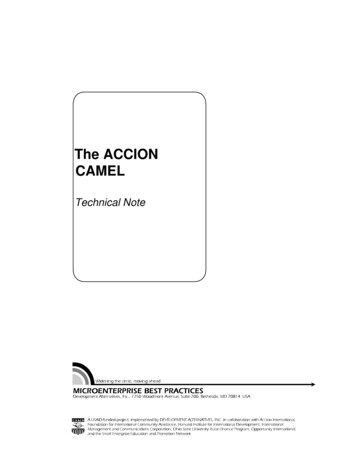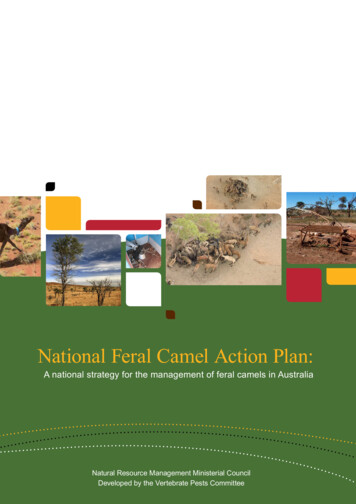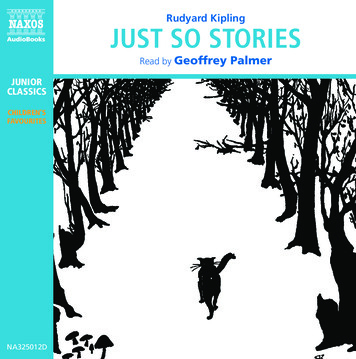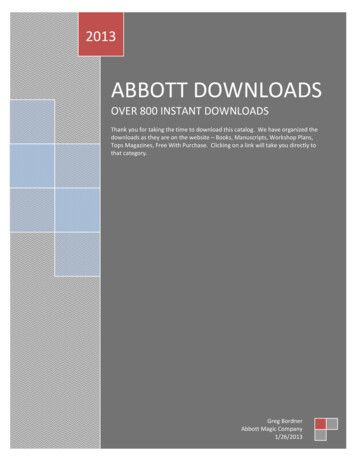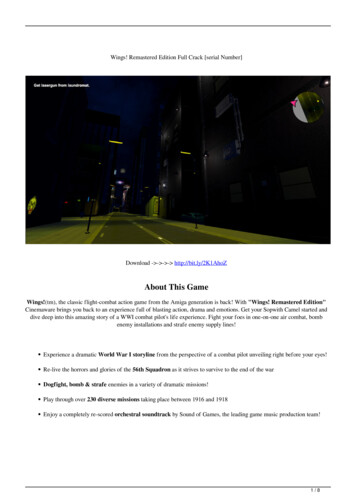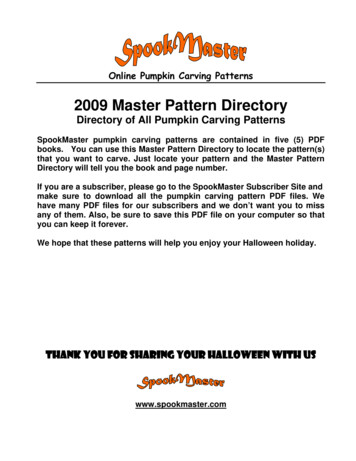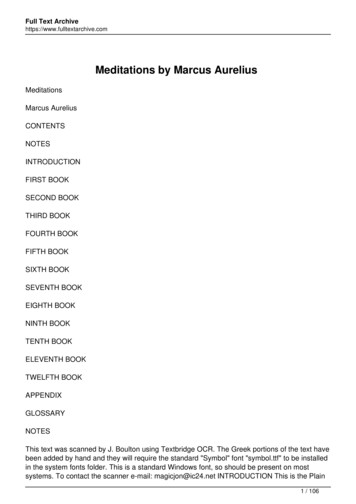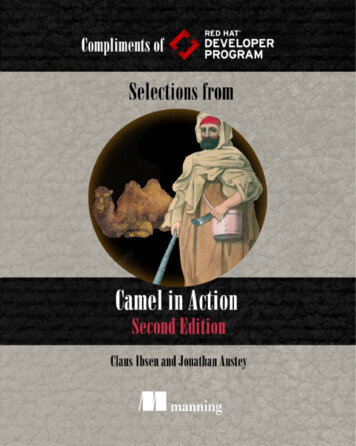
Transcription
Selections fromCamel in Action, Second Editionby Claus Ibsen and Jonathan AnsteyChapter 1Chapter 2Chapter 3Copyright 2018 Manning PublicationsTo pre-order or learn more about these books go to www.manning.com
For online information and ordering of these and other Manning books, please visitwww.manning.com. The publisher offers discounts on these books when ordered in quantity.For more information, please contactSpecial Sales DepartmentManning Publications Co.20 Baldwin RoadPO Box 761Shelter Island, NY 11964Email: orders@manning.com 2018 by Manning Publications Co. All rights reserved.No part of this publication may be reproduced, stored in a retrieval system, or transmitted, inany form or by means electronic, mechanical, photocopying, or otherwise, without prior writtenpermission of the publisher.Many of the designations used by manufacturers and sellers to distinguish their products areclaimed as trademarks. Where those designations appear in the book, and ManningPublications was aware of a trademark claim, the designations have been printed in initial capsor all caps. Recognizing the importance of preserving what has been written, it is Manning’s policy to havethe books we publish printed on acid-free paper, and we exert our best efforts to that end.Recognizing also our responsibility to conserve the resources of our planet, Manning booksare printed on paper that is at least 15 percent recycled and processed without the use ofelemental chlorine.Manning Publications Co.20 Baldwin Road TechnicalPO Box 761Shelter Island, NY 11964Cover designer: Leslie HaimesISBN 9781617295737Printed in the United States of America1 2 3 4 5 6 7 8 9 10 - EBM - 23 22 21 20 19 18
brief contentsPart 1 First steps11 Meeting Camel . 31.11.21.31.41.51.6Introducing Camel 4Getting started 10Camel’s message model 15Camel’s architecture 18Your first Camel ride, revisitedSummary 25242 Routing with Camel .272.12.22.32.42.52.62.7Introducing Rider Auto Parts 28Understanding endpoints 29Creating routes in Java 33Defining routes in XML 39Endpoints revisited 49Routing and EIPs 55Summary and best practices 71Part 2 Core Camel 733 Transforming data with Camel.753.13.23.33.43.53.63.7Data transformation overview 76Transforming data by using EIPs and Java 77Transforming XML 87Transforming with data formats 91Transforming with templates 99Understanding Camel type converters 100Summary and best practices 105iii
ivCHAPTER 1
Part 1First stepsApache Camel is an open source integration framework that aims to makeintegrating systems easier. In the first chapter of this book, we’ll introduce you toCamel and show you how it fits into the bigger enterprise software picture. You’llalso learn the concepts and terminology of Camel.Chapter 2 focuses on message routing, one of Camel’s most important features. Camel has two main ways of defining routing rules: the Java-based domainspecific language (DSL) and the XML configuration format. In addition to theseroute-creation techniques, we’ll show you how to design and implement solutionsto integration problems using enterprise integration patterns (EIPs) and Camel.
1Meeting CamelThis chapter covers¡ An introduction to Camel¡ Camel’s main features¡ Your first Camel ride¡ Camel’s architecture and conceptsBuilding complex systems from scratch is a costly endeavor, and one that’s almostnever successful. An effective and less risky alternative is to assemble a system like ajigsaw puzzle from existing, proven components. We depend daily on a multitude ofsuch integrated systems, making possible everything from phone communications,financial transactions, and health care to travel planning and entertainment.You can’t finalize a jigsaw puzzle until you have a complete set of pieces that pluginto each other simply, seamlessly, and robustly. That holds true for system integration projects as well. But whereas jigsaw puzzle pieces are made to plug into eachother, the systems we integrate rarely are. Integration frameworks aim to fill this gap.As a developer, you’re less concerned about how the system you integrate works andmore focused on how to interoperate with it from the outside. A good integrationframework provides simple, manageable abstractions for the complex systems you’reintegrating and the “glue” for plugging them together seamlessly.3
4CHAPTER 1 Meeting CamelApache Camel is such an integration framework. In this book, we’ll help you understand what Camel is, how to use it, and why we think it’s one of the best integrationframeworks out there. This chapter starts off by introducing Camel and highlightingsome of its core features. We’ll then present the Camel distribution and explain howto run the Camel examples in the book. We’ll round off the chapter by bringing coreCamel concepts to the table so you can understand Camel’s architecture.Are you ready? Let’s meet Camel.1.1Introducing CamelCamel is an integration framework that aims to make your integration projects productive and fun. The Camel project was started in early 2007 and now is a mature opensource project, available under the liberal Apache 2 license, with a strong community.Camel’s focus is on simplifying integration. We’re confident that by the time youfinish reading these pages, you’ll appreciate Camel and add it to your must-have listof tools.This Apache project was named Camel because the name is short and easy to remember. Rumor has it the name may be inspired by the Camel cigarettes once smoked byone of the founders. At the Camel website, a FAQ entry (http://camel.apache.org/whythe-name-camel.html) lists other lighthearted reasons for the name.1.1.1What is Camel?At the core of the Camel framework is a routing engine—or more precisely, a routing-engine builder. It allows you to define your own routing rules, decide from whichsources to accept messages, and determine how to process and send those messages toother destinations. Camel uses an integration language that allows you to define complex routing rules, akin to business processes. As shown in Figure 1.1, Camel forms theglue between disparate systems.One of the fundamental principles of Camel is that it makes no assumptions aboutthe type of data you need to process. This is an important point, because it gives you, thedeveloper, an opportunity to integrate any kind of system, without the need to convertyour data to a canonical format.System AFigure 1.1Transport ATransport BSystem BCamel is the glue between disparate systems.Camel offers higher-level abstractions that allow you to interact with various systemsby using the same API regardless of the protocol or data type the systems are using.Components in Camel provide specific implementations of the API that target different protocols and data types. Out of the box, Camel comes with support for more than280 protocols and data types. Its extensible and modular architecture allows you to
Introducing Camel5implement and seamlessly plug in support for your own protocols, proprietary or not.These architectural choices eliminate the need for unnecessary conversions and makeCamel not only faster but also lean. As a result, it’s suitable for embedding into otherprojects that require Camel’s rich processing capabilities. Other open source projects,such as Apache ServiceMix, Karaf, and ActiveMQ, already use Camel as a way to carryout integration.We should also mention what Camel isn’t. Camel isn’t an enterprise service bus(ESB), although some call Camel a lightweight ESB because of its support for routing,transformation, orchestration, monitoring, and so forth. Camel doesn’t have a container or a reliable message bus, but it can be deployed in one, such as the previouslymentioned Apache ServiceMix. For that reason, we prefer to call Camel an integrationframework rather than an ESB.If the mere mention of ESBs brings back memories of huge, complex deployments,don’t fear. Camel is equally at home in tiny deployments such as microservices or internet-of-things (IoT) gateways.To understand what Camel is, let’s take a look at its main features.1.1.2Why use Camel?Camel introduces a few novel ideas into the integration space, which is why its authorsdecided to create Camel in the first place. We’ll explore the rich set of Camel featuresthroughout the book, but these are the main ideas behind Camel:¡ Routing and mediation engine¡ Extensive component library¡ Enterprise integration patterns (EIPs)¡ Domain-specific language (DSL)¡ Payload-agnostic router¡ Modular and pluggable architecture¡ Plain Old Java Object (POJO) model¡ Easy configuration¡ Automatic type converters¡ Lightweight core ideal for microservices¡ Cloud ready¡ Test kit¡ Vibrant communityLet’s dive into the details of each of these features.ROUTING AND MEDIATION ENGINEThe core feature of Camel is its routing and mediation engine. A routing engine selectively moves a message around, based on the route’s configuration. In Camel’s case,
6CHAPTER 1 Meeting Camelroutes are configured with a combination of enterprise integration patterns and adomain-specific language, both of which we’ll describe next.EXTENSIVE COMPONENT LIBRARYCamel provides an extensive library of more than 280 components. These componentsenable Camel to connect over transports, use APIs, and understand data formats. Tryto spot a few technologies that you’ve used in the past or want to use in the future infigure 1.2. Of course, it isn’t possible to discuss all of these components in the book,but we do cover about 20 of the most widely used. Check out the index if you’re interested in a particular one.Figure 1.2 Connect to just about anything! Camel supports more than 280 transports, APIs,and data formats.
Introducing Camel7ENTERPRISE INTEGRATION PATTERNSAlthough integration problems are diverse, Gregor Hohpe and Bobby Woolf noticedthat many problems, and their solutions are quite similar. They cataloged them in theirbook Enterprise Integration Patterns (Addison-Wesley, 2003), a must-read for any integration professional (www.enterpriseintegrationpatterns.com). If you haven’t read it, weencourage you to do so. At the very least, it’ll help you understand Camel conceptsfaster and easier.The enterprise integration patterns, or EIPs, are helpful not only because theyprovide a proven solution for a given problem, but also because they help define andcommunicate the problem itself. Patterns have known semantics, which makes communicating problems much easier. Camel is heavily based on EIPs. Although EIPs describeintegration problems and solutions and provide a common vocabulary, the vocabularyisn’t formalized. Camel tries to close this gap by providing a language to describe theintegration solutions. There’s almost a one-to-one relationship between the patternsdescribed in Enterprise Integration Patterns and the Camel DSL.DOMAIN-SPECIFIC LANGUAGEAt its inception, Camel’s domain-specific language (DSL) was a major contribution tothe integration space. Since then, several other integration frameworks have followedsuit and now feature DSLs in Java, XML, or custom languages. The purpose of theDSL is to allow the developer to focus on the integration problem rather than on thetool—the programming language. Here are some examples of the DSL using differentformats and staying functionally equivalent:¡ Java � XML DSL route from uri "file:data/inbox"/ to uri "jms:queue:order"/ /route These examples are real code, and they show how easily you can route files from afolder to a Java Message Service (JMS) queue. Because there’s a real programming language underneath, you can use the existing tooling support, such as code completionand compiler error detection, as illustrated in figure 1.3.
8CHAPTER 1 Meeting CamelFigure 1.3 Camel DSLs use real programming languages such as Java, so you can use existingtooling support.Here you can see how the Eclipse IDE’s autocomplete feature can give you a list of DSLterms that are valid to use.PAYLOAD-AGNOSTIC ROUTERCamel can route any kind of payload; you aren’t restricted to carrying a normalizedformat such as XML payloads. This freedom means you don’t have to transform yourpayload into a canonical format to facilitate routing.MODULAR AND PLUGGABLE ARCHITECTURECamel has a modular architecture, which allows any component to be loaded intoCamel, regardless of whether the component ships with Camel, is from a third party, oris your own custom creation. You can also configure almost anything in Camel. Manyof its features are pluggable and configurable—anything from ID generation, threadmanagement, shutdown sequencer, stream caching, and whatnot.POJO MODELJava beans (or Plain Old Java Objects, POJOs) are considered first-class citizens inCamel, and Camel strives to let you use beans anywhere and anytime in your integration projects. In many places, you can extend Camel’s built-in functionality with yourown custom code. Chapter 4 has a complete discussion of using beans within Camel.EASY CONFIGURATIONThe convention over configuration paradigm is followed whenever possible, which minimizes configuration requirements. In order to configure endpoints directly in routes,Camel uses an easy and intuitive URI configuration.For example, you could configure a Camel route starting from a file endpoint to scanrecursively in a subfolder and include only .txt files, as follows:from("file:data/inbox?recursive true&include .*txt ").
Introducing Camel9AUTOMATIC TYPE CONVERTERSCamel has a built-in type-converter mechanism that ships with more than 350 converters. You no longer need to configure type-converter rules to go from byte arrays tostrings, for example. And if you need to convert to types that Camel doesn’t support,you can create your own type converter. The best part is that it works under the hood,so you don’t have to worry about it.The Camel components also use this feature; they can accept data in most types andconvert the data to a type they’re capable of using. This feature is one of the top favorites in the Camel community. You may even start wondering why it wasn’t provided inJava itself! Chapter 3 covers more about type converters.LIGHTWEIGHT CORE IDEAL FOR MICROSERVICESCamel’s core can be considered lightweight, with the total library coming in at about4.9 MB and having only 1.3 MB of runtime dependencies. This makes Camel easy toembed or deploy anywhere you like, such as in a standalone application, microservice,web application, Spring application, Java EE application, OSGi, Spring Boot, WildFly, and in cloud platforms such as AWS, Kubernetes, and Cloud Foundry. Camel wasdesigned not to be a server or ESB but instead to be embedded in whatever runtimeyou choose. You just need Java.CLOUD READYIn addition to Camel being cloud-native (covered in chapter 18), Camel also providesmany components for connecting with SaaS providers. For example, with Camel youcan hook into the following:¡ Amazon DynamoDB, EC2, Kinesis, SimpleDB, SES, SNS, SQS, SWF, and S3¡ Braintree (PayPal, Apple, Android Pay, and so on)¡ Dropbox¡ Facebook¡ GitHub¡ Google Big Query, Calendar, Drive, Mail, and Pub Sub¡ HipChat¡ LinkedIn¡ Salesforce¡ Twitter¡ And more.TEST KITCamel provides a test kit that makes it easier for you to test your own Camel applications. The same test kit is used extensively to test Camel itself, and it includes morethan 18,000 unit tests. The test kit contains test-specific components that, for example,can help you mock real endpoints. It also allows you to set up expectations thatCamel can use to determine whether an application satisfied the requirements orfailed. Chapter 9 covers testing with Camel.
10CHAPTER 1 Meeting CamelVIBRANT COMMUNITYCamel has an active community. It’s a long-lived one too. It has been active (and growing) for more than 10 years at the time of writing. Having a strong community is essential if you intend to use any open source project in your application. Inactive projectshave little community support, so if you run into issues, you’re on your own. WithCamel, if you’re having any trouble, users and developers alike will come to your aid.For more information on Camel’s community, see appendix B.Now that you’ve seen the main features that make up Camel, you’ll get morehands-on by looking at the Camel distribution and trying an example.1.2Getting startedThis section shows you how to get your hands on a Camel distribution and explainswhat’s inside. Then you’ll run an example using Apache Maven. After this, you’ll knowhow to run any of the examples from the book’s source code.Let’s first get the Camel distribution.1.2.1Getting CamelCamel is available from the official Apache Camel website at http://camel.apache.org/download.html. On that page, you’ll see a list of all the Camel releases and the downloads for the latest release.For the purposes of this book, we’ll be using Camel 2.20.1. To get this version, clickthe Camel 2.20.1 Release link. Near the bottom of the page, you’ll find two binary distributions: the zip distribution is for Windows users, and the tar.gz distribution is formacOS/Linux users. After you’ve downloaded one of the distributions, extract it to alocation on your hard drive.Open a command prompt and go to the location where you extracted the Camel distribution. Issuing a directory listing here will give you something like this:[janstey@ghost apache-camel-2.20.1] lsdoc examples lib LICENSE.txt NOTICE.txt README.txtAs you can see, the distribution is small, and you can probably guess what each directory contains already. Here are the details:¡ doc—Contains the Camel manual in HTML format. This manual is a downloadof a large portion of the Apache Camel website at the time of release. As such, it’sa decent reference for those unable to access the Camel website (or if you misplaced your copy of Camel in Action).¡ examples—Includes 97 Camel examples.¡ lib—Contains all Camel libraries. You’ll see later in the chapter how Maven canbe used to easily download dependencies for the components outside the core.¡ LICENSE.txt—Contains the license of the Camel distribution. Because this is anApache project, the license is the Apache License, version 2.0.
Getting started11¡ NOTICE.txt—Contains copyright information about the third-party dependen-cies included in the Camel distribution.¡ README.txt—Contains a short intro to Camel and a list of helpful links to getnew users up and running.Now let’s try the first Camel example from this book.1.2.2Your first Camel rideSo far, we’ve shown you how to get a Camel distribution and offered a peek at what’sinside. At this point, feel free to explore the distribution; all examples have instructions to help you figure them out.From this point on, though, we won’t be using the distribution at all. All the examples in the book’s source use Apache Maven, which means that Camel libraries will bedownloaded automatically for you—there’s no need to make sure the Camel distribution’s libraries are on the classpath.You can get the book’s source code from the GitHub project that’s hosting the ion2).The first example you’ll look at can be considered the “hello world” of integrations:routing files. Suppose you need to read files from one directory (data/inbox), processthem in some way, and write the result to another directory (data/outbox). For simplicity, you’ll skip the processing, so your output will be merely a copy of the original file.Figure 1.4 illustrates this process.data/inboxFiledata/outboxFigure 1.4 Files are routed from the data/inboxdirectory to the data/outbox directory.It looks simple, right? Here’s a possible solution using pure Java (with no Camel).Listing 1.1importimportimportimportimportRouting files from one folder to another in plain Stream;public class FileCopier {public static void main(String args[]) throws Exception {File inboxDirectory new File("data/inbox");File outboxDirectory new File("data/outbox");outboxDirectory.mkdir();File[] files inboxDirectory.listFiles();for (File source : files) {if (source.isFile()) {File dest new File(
12CHAPTER 1 Meeting CameloutboxDirectory.getPath() File.separator source.getName());copyFile(source, dest);}}}private static void copyFile(File source, File dest)throws IOException {OutputStream out new FileOutputStream(dest);byte[] buffer new byte[(int) source.length()];FileInputStream in new FileInputStream(source);in.read(buffer);try {out.write(buffer);} finally {out.close();in.close();}}}This FileCopier example is a simple use case, but it still results in 37 lines of code.You have to use low-level file APIs and ensure that resources get closed properly—atask that can easily go wrong. Also, if you want to poll the data/inbox directory for newfiles, you need to set up a timer and keep track of which files you’ve already copied.This simple example is getting more complex.Integration tasks like these have been done thousands of times before; you shouldn’tever need to code something like this by hand. Let’s not reinvent the wheel here.Let’s see what a polling solution looks like if you use an integration framework such asApache Camel.Listing 1.2Routing files from one folder to another with Apache Camelimport org.apache.camel.CamelContext;import org.apache.camel.builder.RouteBuilder;import org.apache.camel.impl.DefaultCamelContext;public class FileCopierWithCamel {public static void main(String args[]) throws Exception {CamelContext context new DefaultCamelContext();context.addRoutes(new RouteBuilder() {public void configure() {from("file:data/inbox?noop true")➊ Routes files frominbox to Thread.sleep(10000);context.stop();}}
13Getting startedMost of this code is boilerplate stuff when using Camel. Every Camel application usesa CamelContext that’s subsequently started and then stopped. You also add a sleepmethod to allow your simple Camel application time to copy the files. What you shouldfocus on in listing 1.2 is the route ➊.Routes in Camel are defined in such a way that they flow when read. This route can beread like this: consume messages from file location data/inbox with the noop optionset, and send to file location data/outbox. The noop option tells Camel to leave thesource file as is. If you didn’t use this option, the file would be moved. Most peoplewho’ve never seen Camel before will be able to understand what this route does. Youmay also want to note that, excluding the boilerplate code, you created a file-pollingroute in just two lines of Java code ➊.To run this example, you need to download and install Apache Maven from theMaven site at http://maven.apache.org/download.html. When you have Maven up andworking, open a terminal and browse to the chapter1/file-copy directory of the book’ssource. If you take a directory listing here, you’ll see several things:¡ data—Contains the inbox directory, which itself contains a single file named mes-sage1.xml.¡ src—Contains the source code for the listings shown in this chapter.¡ pom.xml—Contains information necessary to build the examples. This is theMaven Project Object Model (POM) XML file.NOTE We used Maven 3.5.0 during the development of the book. Differentversions of Maven may not work or appear exactly as we’ve shown.The POM is shown in the following listing.Listing 1.3The Maven POM required to use Camel’s core library project xmlns "http://maven.apache.org/POM/4.0.0"xmlns:xsi emaLocation che.org/xsd/maven-4.0.0.xsd" modelVersion 4.0.0 /modelVersion parent groupId com.camelinaction /groupId ➊ Parent POM artifactId chapter1 /artifactId version 2.0.0 /version /parent artifactId chapter1-file-copy /artifactId name Camel in Action 2 :: Chapter 1 :: File Copy Example /name dependencies dependency groupId org.apache.camel /groupId artifactId camel-core /artifactId /dependency ➋ Camel’s core library
14CHAPTER 1 Meeting Camel dependency groupId org.slf4j /groupId artifactId slf4j-log4j12 /artifactId /dependency /dependencies /project Logging supportMaven itself is a complex topic, and we don’t go into great detail here. We’ll give youenough information to be productive with the examples in this book. Chapter 8 alsocovers using Maven to develop Camel applications, so there’s a good deal of information there too.The Maven POM in listing 1.3 is probably one of the shortest POMs you’ll ever see—almost everything uses the defaults provided by Maven. Besides those defaults, somesettings are configured in the parent POM ➊. Probably the most important section topoint out here is the dependency on the Camel library ➋. This dependency elementtells Maven to do the following:12345Create a search path based on the groupId, artifactId, and version. The version element is set to the camel-version property, which is defined in the POMreferenced in the parent element ➊, and resolves to 2.20.1. The type of dependency isn’t specified, so the JAR file type is assumed. The search path is .1.jar.Because listing 1.3 defines no special places for Maven to look for the Cameldependencies, it looks in Maven’s central repository, located at http://repo1.maven.org/maven2.Combining the search path and the repository URL, Maven tries to amel/camel-core/2.20.1/camelcore-2.20.1.jar.This JAR is saved to Maven’s local download cache, which is typically locatedin the home directory under the .m2/repository. This is /.m2/repository onLinux/macOS, and C:\Users\ Username \.m2\repository on recent versions ofWindows.When the application code in listing 1.2 is started, the Camel JAR is added to theclasspath.To run the example in listing 1.2, change to the chapter1/file-copy directory and usethe following command:mvn compile exec:javaThis instructs Maven to compile the source in the src directory and to execute theFileCopierWithCamel class with the camel-core JAR on the classpath.
Camel’s message model15NOTETo run any of the examples in this book, you need an internet connection. Apache Maven will download many JAR dependencies of the examples. The whole set of examples will download several hundred megabytes oflibraries.Run the Maven command from the chapter1/file-copy directory, and after it completes, browse to the data/outbox folder to see the file copy that’s just been made.Congratulations—you’ve run your first Camel example! It’s a simple one, but knowinghow it’s set up will enable you to run pretty much any of the book’s examples.We now need to cover Camel basics and the integration space in general to ensurethat you’re well prepared for using Camel. We’ll turn our attention to the messagemodel, the architecture, and a few other Camel concepts. Most of the abstractions arebased on known EIP concepts and retain their names and semantics. We’ll start withCamel’s message model.1.3Camel’s message modelCamel uses two abstractions for modeling messages, both of which we cover in thissection:¡ org.apache.camel.Message—The fundamental entity containing the databeing carried and routed in Camel.¡ org.apache.camel.Exchange—The Camel abstraction for an exchange ofmessages. This exchange of messages has an in message, and as a reply, an outmessage.We’ll start by looking at messages so you can understand the way data is modeled andcarried in Camel. Then we’ll show you how a “conversation” is modeled in Camel bythe exchange.1.3.1MessageMessages are the entities used by systems to communicate with each other when usingmessaging channels. Messages flow in one direction, from a sender to a receiver, asillustrated in figure 1.5.SenderReceiverMessageFigure 1.5 Messages are entities used tosend data from one system to another.Messages have a body (a payload), headers, and optional attachments, as illustrated infigure 1.6.
16CHAPTER 1 Meeting CamelMessageHeadersAttachmentsBodyFigure 1.6 A message can containheaders, attachments, and a body.Messages are uniquely identified with an identifier of type java.lang.String. Theidentifier’s uniqueness is enforced and guaranteed by the message creator, it’s protocol dependent, and it doesn’t have a guaranteed format. For protocols that don’tdefine a unique message identification scheme, Camel uses its own ID generator.HEADERS AND ATTACHMENTSHeaders are values associated with the message, such as sender identifiers, hints aboutcontent encoding, authentication information, and so on. Headers are name-valuepairs; the name is a unique, case-insensitive string, and the value is of type java.lang.Object. Camel imposes no constraints on the type of the headers. There are also noconstraints on the size of headers or on the number of headers included with a message. Headers are stored as a map within the message. A message can also have optionalattachments, which are typically used for the web service and email components.BODYThe body is of type java.lang.Object, so a message can store any kind of content andany size. It’s up to the application designer to make sure that the receiver can understand the content of the message. When the sender and receiver use different bodyformats, Camel provides mechanisms to transform the data into an acceptable format,and in those cases the conversion happens automatically with type converters, behindthe scenes. Chapter 3 fully covers message transformation.FAULT FLAGMessages also have a fault flag. A few protocols and specifications, such as SOAP WebServices, distinguish between output and fault messages. They’re both valid responsesto invoking an operation, but the latter i
Figure 1.1 Camel is the glue between disparate systems. Camel offers higher-level abstractions that allow you to interact with various systems by using the same API regardless of the protocol or data type the systems are using. Components in Camel provide speci!c implementations of the API that target differ-ent protocols and data types.
